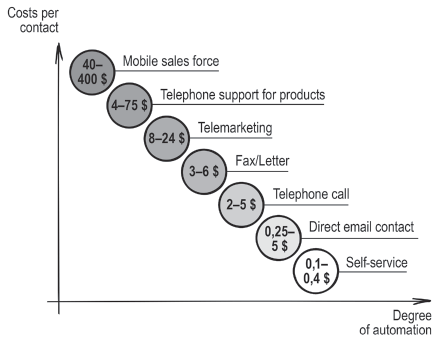Self-Service
Putting the customer to work

The pattern
In the Self-Service model, a part of the value creation of a product or service is handed over to the customer in exchange for a lower price (HOW?). This is particularly suited to processes that generate high costs but add relatively low perceived value for the customer. In addition to lower prices, customers typically find that Self-Service saves them time (WHAT?). It may even increase efficiency, since in some cases customers can execute a value-adding step more rapidly and in a more target-oriented fashion. Classic applications include picking items up from shelves, planning their own projects, or autonomously conducting the payment transactions for products and services. A Self-Service business has a large savings potential, and customer labour can often replace a significant number of staff positions (VALUE?).

The origins
The Self-Service business model originated in the United States, where it led to the establishment of Self-Service stores at the beginning of the 20th century. Whereas customers had always been served at counters in ‘mom and pop stores’, they now had to fetch their own groceries from shelves. The concept of Self-Service developed with the general desire for increased productivity and efficiency that came with industrialisation. Anecdotal evidence even suggests that Self-Service grew out of a situation where stressed customers became impatient and started helping themselves to items on shop shelves. Over time, Self-Service stores became a familiar sight outside of North America too: Sweden and Germany were among the first European nations to open Self-Service stores, in the 1930s and after the Second World War respectively.
The innovators
With the need for efficiency in areas other than retail, the Self-Service model spread to other industries. We would be remiss not to mention the Swedish furniture company IKEA – a manufacturer of ready-to-assemble furniture, appliances and home accessories. IKEA customers are integrated into the value creation process by purchasing self-assembly products (beds, chairs, tables, etc.) and bringing them home themselves. IKEA displays its products on a sales floor for customers to browse and consider for purchase, after which the customers are required to collect them from the warehouse in compact (‘flat pack’) packaging for self-assembly. The company saves immensely on distribution and production costs and increases revenue by providing products at very competitive prices with this form of Self-Service. Inventory costs are also much lower than those of traditional furniture manufacturers since IKEA’s flat-packed items require considerably less warehouse space. Today, IKEA’s business model has attained cult status, but even when it was first introduced over 70 years ago it revolutionised the furniture industry.
One of the most famous examples of the Self-Service business model is the fast food restaurant McDonald’s, which bases a major part of its business on this concept and ranks among the world’s largest franchises. McDonald’s offers standardised menus of hamburgers, cheeseburgers, chicken, French fries, breakfasts, soft drinks and desserts in its restaurants in 119 countries around the world, in the form of franchises or run by the corporation itself. In most restaurants, customers order their meals from staff at a counter, receive the food immediately and proceed to a table. There is no waiting staff serving customers. Other Self-Service options available at some of the restaurants include drive-through and walk-through facilities. McDonald’s focuses on its key service to provide competitively priced fast food, reducing costs on waiting staff and other overheads and thus increasing customer throughput and profit.
The Self-Service concept has also been applied in bakeries. BackWerk was the first such bakery in Germany. At BackWerk, instead of being served at counters in the traditional manner, customers browse and personally select from a wide variety of products in glass-fronted display cases without the aid of store personnel. They use the tongs provided to put the selection of products they wish to purchase on a tray, and then proceed directly to the cashier at the point of sale. Since customers take over some of the value creation process, the company greatly reduces its personnel costs by providing only the most necessary services (the cashier, for example) and can therefore offer its products for about 30 to 45 per cent less than its traditional competitors. BackWerk has enjoyed considerable success with this business model and currently operates over 350 stores.
Supermarkets are also expanding the Self-Service principle. Although tested by Swiss grocery shops in 1965, only with new technological developments has the payment process now increasingly outsourced to the customer. In more and more supermarkets, goods can be recorded and paid for by customers themselves at the end of the shopping process. As a global phenomenon, with several renowned companies approaching this (e.g. Walmart, REWE), in Switzerland some supermarket chains, such as Coop or Migros, even go one step further and offer their customers the option of scanning their goods with a barcode scanner while they are shopping; the same is available at supermarkets in the UK. The next level in this Self-Service approach is the fully automated assignment of bought products alongside the shopping experience, as targeted by Amazon’s currently developing concept of camera-supported grocery stores.
When and how to apply Self-Service
The Self-Service pattern is good for customers who are willing to take on some additional work in exchange for lower prices. This pattern is also beneficial when a DIY element in the manufacturing process creates perceived customer value, e.g. T-shirts that customers can design themselves. In order to successfully implement Self-Service, you must analyse the potential of the pattern from your customers’ point of view.
Some questions to ask
- How do we position ourselves against full-service competitors?
- How should we price Self-Service?
- Are we delivering the kind of value customers expect?
- Will customers perceive the work they take on as a positive experience?
- How can we ensure that the processes around customers’ inputs are robust and error-free?

